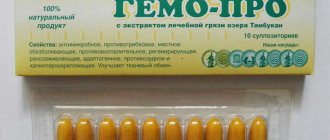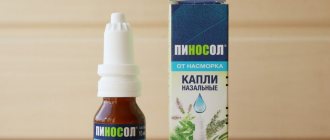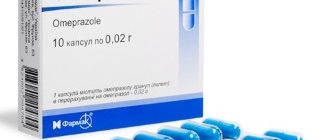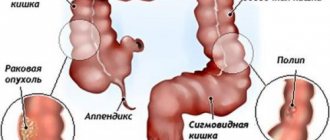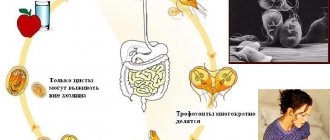Pharmacodynamics and pharmacokinetics
Pharmacodynamics
A combined drug that normalizes digestive processes due to the enzymes it contains. Reduces gas formation and accelerates gastrointestinal . Papain and fungal diastase are plant digestive enzymes. Papain is a proteolytic enzyme that is obtained from the milky juice of papaya fruit. It hydrolyzes proteins , and fungal diastase hydrolyzes carbohydrates, making their digestion and absorption easier. Simethicone affects the surface tension of gas bubbles, reduces it and the bubbles disintegrate. Gases are absorbed by the intestines and are also eliminated through peristaltic movements of the intestines.
When the effervescent tablet dissolves, and potassium citrates hydrochloric acid . In this regard, heartburn and discomfort associated with increased acidity are reduced. The antacid effect of the drug protects digestive enzymes from the aggressive action of gastric juice.
Pharmacokinetics
The active substances are chemically inert, are not absorbed and are excreted through the gastrointestinal tract unchanged.
Instructions for use
pharmachologic effect
Pepphysis is a combined drug that has a digestive enzyme effect, reduces gas formation in the intestines, and accelerates gastrointestinal motility.
Fungal diastase and papain are digestive enzymes that facilitate the digestion of carbohydrates and proteins, promoting more complete absorption of these components in the small intestine. Papain hydrolyzes proteins and peptides, and fungal diastase hydrolyzes carbohydrates (glycogen, starch, and their metabolic products).
As for simethicone, it helps to reduce the surface tension of gas bubbles and their disintegration. The released gases are absorbed by the intestinal walls and, thanks to intestinal peristalsis, are eliminated. Effervescent tablets quickly dissolve in liquid to release potassium citrate and sodium citrate, which neutralize the effect of HCl in the stomach, reducing symptoms caused by high acidity.
The antacid effect develops quickly and protects digestive enzymes from the destructive effects of gastric juice.
The drug eliminates excess gas formation, makes you feel better with bloating and colic.
Indications for use
Pepfiz is prescribed to patients with pathological conditions associated with damage to the exocrine functions of the pancreas. In the presence of such conditions, complex therapy is carried out, one of the components of which is the use of Pepphys.
Typically, the drug is prescribed for diseases caused by delayed gastric emptying and digestive enzyme deficiency.
Pepphys helps suppress:
A drug that improves the functional state of the gastrointestinal tract of chronic pancreatitis;- liver diseases;
- non-ulcer dyspepsia syndrome;
- pathologies in the proximal parts of the small intestine;
- enteritis;
- flatulence;
- feelings of a full stomach (from overeating, drinking coffee or alcohol, smoking, eating unusual foods);
- intense gas formation after surgical interventions.
Pepfiz is often prescribed to patients in preparation for ultrasound and x-ray examinations of the abdominal cavity.
Since the drug is “free” from animal enzymes, it does not cause unwanted reactions caused by an imbalance of uric acid (urolithiasis, gout). Pepfiz does not contain lipase, so it cannot induce weight gain. Often this drug is prescribed to patients who, for one reason or another, cannot tolerate drugs with animal enzymes.
Mode of application
Pepphysis is taken orally, after meals. Before use, the effervescent tablet is removed from the strip and completely dissolved in half (130 ml) glass of water.
As part of the standard dosing regimen, take one tablet two to three times a day.
When preparing for an x-ray or ultrasound examination of the abdominal organs, the drug should be taken one to two days before the procedure. Do this twice a day (evening, morning) 1 or 2 tablets.
Release form, composition
The drug is approved for use as an over-the-counter tablet. fizzy
The drug Pepfiz is flat and round effervescent tablets with the smell of orange and beveled edges. The color of the tablets varies from white-pink to pure white. There may be pinpoint inclusions. Tablets are packaged in strips and cartons. One strip contains 2 tablets, one package contains 1, 2 or 7 strips.
Each Pepfiz tablet contains 60 mg of papain, 20 mg of fungal diastase and 25 mg of simethicone. The list of auxiliary components includes substances such as sodium bicarbonate, potassium bicarbonate, saccharin, sodium lauryl sulfate, dye, citric acid, fumaric acid, sodium carbonate, flavoring.
Interaction with other drugs
Parallel use of Pepfiz with antacids is undesirable. Other interactions have not been described by the drug manufacturer.
Reviews of Pepfiz
Pepphys is a type of defoamer, but its effectiveness is enhanced by enzymatic components. Pepfiz tablets are naturally acid-resistant, so they are used in liquid form (the tablet dissolves in water), this improves mixing with food and is convenient when treating children. The drug eliminates symptoms associated with gas formation, high acidity and insufficient digestion of carbohydrates and proteins.
Judging by the reviews, the drug was used for various functional digestive disorders to eliminate: nausea, belching, a feeling of heaviness and discomfort in the stomach, flatulence and diarrhea . Many patients report a noticeable improvement in their condition when taking this drug. The phenomena of gas formation decreased quickly, even if the diet was not followed. A decrease in bloating was noted already on the third day, and after two weeks there was a persistent relief of this symptom. The drug can be used as an emergency treatment. No side effects were observed.
- “... A fast-acting drug - it eliminates bloating and rumbling in my stomach, a feeling of fullness in the stomach.”
- “... It helped me - my appetite normalized and the heaviness in my stomach and nausea disappeared.”
- “... I took Pepfiz and got rid of rumbling in my stomach and heaviness in my stomach. The stool has returned to normal."
- “... A pleasant medicine, it was effective for me when taken for a long time - the pain after eating and belching disappeared.”
- “... I'm worried about flatulence, especially in the morning. I took Pepfiz, Espumisan, Bifidumbacterin. Does not help. Apparently we need to be seriously examined by a gastroenterologist.”
Many patients did not like the taste of the drug.
- “... In my opinion, it was possible to do without dyes and flavors, because this is medicine.”
- "… I did not like. The taste is too sweet, so I couldn’t take more than one tablet. Why add sweeteners and colorings to the preparation.”
However, it should be noted that this drug is less effective and is not suitable for replacement therapy of severe pancreatitis with impaired enzyme function, since the enzyme activity in the drug is low - 75 times less than that of drugs of animal origin. As you can see, the selection of an enzyme preparation is individual and complex, since it is necessary to take into account the characteristics of digestive disorders in each patient.
Side effects
Judging by people's reviews, the use of Pepfiz rarely leads to the development of undesirable effects. The only possible side effects are mild allergic reactions that occur in patients predisposed to allergies.
Overdose
There have been no reports of overdose with Pepfiz yet.
- If you have any symptoms of the disease, you should immediately consult a doctor. You can view a list of gastroenterology clinics on our website
- You will be interested! The article describes symptoms that make it possible to suspect the presence of liver disease in the early stages
- You will also be interested in learning more about the treatment of various diseases of the gastrointestinal tract
Contraindications
The effervescent tablet dissolves quickly in water to release sodium citrate and potassium citrate. The drug is not prescribed:
- children under 12;
- pregnant patients;
- people with hypersensitivity to the ingredients of the medication;
- women who are breastfeeding.
For diseases of the kidneys, liver, as well as arterial hypertension, Pepfiz should be used with extreme caution.
During pregnancy
Pepfiz is not prescribed to nursing mothers and pregnant patients.
Storage conditions and periods
Pepfiz can be stored for two years, subject to the manufacturer's recommendations. In other words, the drug can be stored at temperatures below 25 °C.
All gastroenterology clinics and medical centers in your city. Tests and ultrasound. Consultation with a gastroenterologist. Diseases of the digestive system. Find out more: - In Kiev (Hertz, Ilaya, Euromed) - In St. Petersburg (SM-Clinic, Longevity, Allergomed, Doctor +, BaltZdrav, Professor) - In Moscow (SM-Clinic, Medlux, Onmed) - In Kharkov ( TsMEI, Olympic, Victoria, Fortis, Ecomed) - In Minsk (Belgirudo, Art-Med-Company, Sinlab, Mikosha, GrandMedica, MedClinic) - in Odessa (Medea, On Clinic, Into Sano, Venus) - In Razyan (Trust + , Polyclinic-Pesochnya, Evrikas +) - in Nizhny Novgorod (Only Clinic, Alpha Center, EuroClinic, SOLO, Altea) - gastroenterological clinics of Tyumen (Doctor A+, Clinic "Vera", Avicenna, Medis, Sibirina, Your Doctor)
The use of enzyme preparations for digestive disorders in children
Digestion is a single, holistic process due to the close relationships between the activities of various parts of the digestive tract. Dysfunction of one part of the gastrointestinal tract, as a rule, leads to dysfunction of other organs. Different processes of absorption of nutrients occur in different parts of the digestive tract. In the stomach - protein breakdown, secretion of internal factor, oxidation of iron ions; in newborns - the breakdown of fats (formation of diglycerides under the action of gastric lipase). In the duodenum - entry of bile acids, emulsification of fat, breakdown of triglycerides, formation of mono- and diglycerides, breakdown of starch and disaccharides, breakdown of protein, absorption of monosaccharides, amino acids, iron, calcium, zinc, magnesium. In the jejunum - breakdown of disaccharides; absorption of monosaccharides, monoglycerides, bile acids, fat-soluble vitamins, folate, calcium, iron, magnesium, zinc, vitamin B12. In the ileum - absorption of bile salts, water, sodium, and the main amount of vitamin B12. In the large intestine - absorption of water, potassium, sodium, calcium, bile salts.
An important digestive organ in the body is the pancreas (PG), which performs an exocrine function. When food enters the gastrointestinal tract, the pancreas secretes into the small intestine not only pancreatic enzymes, but also bicarbonates, which neutralize hydrochloric acid and maintain an alkaline environment in the duodenum, necessary for the normal functioning of pancreatic enzymes. Under physiological conditions, the pancreas produces from 50 to 2500 ml of secretion per day, depending on the age of the person and the nature of the incoming food. Pancreatic juice is a colorless liquid with an alkaline reaction (pH 7.8–8.4). It contains organic substances (proteins) and inorganic components (bicarbonates, electrolytes, trace elements), as well as mucus of the excretory ducts. The enzymatic part of the secretion is formed in acinar cells, and the liquid (water-electrolyte) part - mucin and bicarbonates - by the ductal epithelium. With the help of pancreatic enzymes (lipase, amylase and proteases), which play a key role in the exocrine function of the pancreas, the breakdown of nutrients occurs. Most of them are in an inactive form - these are proenzymes that are activated in the duodenum by enterokinase. Lipase, amylase and ribonuclease are secreted in active form. This mechanism determines the activity of pancreatic juice in the intestinal cavity, which, in turn, protects pancreatic tissue from autolysis.
Digestive enzymes of the pancreas have their own targets: amylase - α-1,4-glycosidic bonds of starch, glycogen; lipase - triglycerides (formation of di-monoglycerides and fatty acids); phospholipase A - phosphatidylcholine (formation of lysophosphatidylcholine and fatty acids); carboxylesterase - cholesterol esters, esters of fat-soluble vitamins, tri-, di-, monoglycerides; trypsin - internal protein bonds (basic amino acids); chymotrypsin - internal protein bonds (aromatic amino acids, leucine, glutamine, methionine); elastase - internal bonds of proteins (neutral amino acids); carboxypeptidase A and B - external bonds of proteins, including aromatic and neutral aliphatic amino acids (A) and basic (B) amino acids from the carboxyl end.
The last four enzymes are secreted by the pancreas in an inactive form (proenzymes) and are activated in the duodenum.
Exocrine pancreatic dysfunction is observed in various hereditary and acquired diseases and may be caused by impaired formation of pancreatic enzymes or their activation in the small intestine. Due to pancreatic dysfunction, accompanied by enzyme deficiency, a disorder of food digestion (maldigestion) and absorption of nutrients (malabsorption) in the intestine develops.
Maldigestion in children is caused by a number of disorders.
- Decreased activity of pancreatic enzymes. It can be caused by chronic or acute pancreatitis, cystic fibrosis, congenital pathology of the pancreas - morphological anomalies of the pancreas (abberant pancreas, ring-shaped pancreas, stenosis of the papilla of Vater or sphincter of Oddi, cysts, bifurcated pancreas), hereditary syndromes accompanied by congenital pancreatic insufficiency (Shwachman syndrome). Diamond, pancreatic insufficiency syndrome with multiple anomalies, deafness and dwarfism (Iohanson-Bizzard), pancreatic insufficiency syndrome with vacuolation of bone marrow cells and sideroblastic anemia (Pearson); isolated enzymatic deficiency (lipase - Sheldon-Rey syndrome; amylase, trypsin, enterokinase) , as well as pancreatic trauma, pancreatic carcinoma, primary sclerosing cholangitis.
- Bile acid deficiency in the small intestine associated with functional disorders of the biliary tract, hepatitis, liver cirrhosis, biliary obstruction.
- Violation of cholecystokinin synthesis caused by damage to the duodenal bulb (chronic duodenitis, chronic gastroduodenitis).
- Inactivation of pancreatic enzymes in the small intestine as a result of intestinal dysbiosis or rapid passage of food.
- Impaired mixing of enzymes with food chyme associated with gastro- and duodenostasis.
The cause of malabsorption is a violation of the activity of the secretion of intestinal enzymes, caused by disaccharidase deficiency, a gastrointestinal form of food allergy, a violation of intracellular digestion (celiac disease, Crohn's disease, enteritis, etc.), a violation of the transport of absorbed substances (exudative enteropathy, lymphoma, tumors, tuberculosis).
It is known that the pancreas has great compensatory capabilities, and disorders of pancreatic secretion appear only in cases of severe damage to the gland. There is an opinion that severe steatorrhea and creatorrhea in adults develop in cases where the secretion of pancreatic lipase and trypsin decreases by more than 90%. However, such a threshold has not been established in children.
The causes and mechanisms of development of exocrine pancreatic insufficiency are varied. There are absolute pancreatic insufficiency, caused by a decrease in the volume of functioning pancreatic parenchyma, and relative, which can be associated with various diseases of the gastrointestinal tract.
If symptoms indicating exocrine pancreatic insufficiency are identified, it is necessary to begin replacement therapy with pancreatic enzymes as early as possible, before malabsorption begins to develop.
Clinical signs of exocrine pancreatic insufficiency are:
- stomach ache,
- loss of appetite,
- flatulence,
- unstable chair,
- steatorrhea,
- nausea,
- recurrent vomiting,
- general weakness,
- weight loss,
- decreased physical activity,
- growth retardation (in severe forms).
There are quite a large number of methods for assessing the digestive capacity of the gastrointestinal tract.
- Determination of the content of pancreatic enzymes in the blood and urine. In acute pancreatitis, the level of amylase in the blood and urine can increase 5-10 times; the level of amylase and lipase in the blood during exacerbation of chronic pancreatitis can be normal or increase for a short time by 1-2 times (from several hours to several days), determination of elastase-1 in the blood plasma, the level of its increase reflects the severity of pancreatitis. The development of hyperenzymemia depends on the period and severity of pancreatitis.
- Scatological research. It should be recognized that scatological research has not lost its relevance to this day and is the most accessible method. It should be carried out before prescribing pancreatic enzymes to the patient. However, the accuracy of this method is also influenced by the state of intestinal motility, the volume of bile secreted into the intestinal lumen, its qualitative composition, the presence of inflammatory processes in the intestine, etc.
In case of digestive disorders, the following symptoms are identified: steatorrhea - the presence of neutral fat in the stool (type 1 steatorrhea); fatty acids, soap (type 2 steatorrhea); both (steatorrhea type 3); creativeorrhea - may be a sign of a violation of the exocrine function of the pancreas. Normally, there are very few muscle fibers in feces; amilorrhea - the presence of a large number of starch grains in the stool - indicates a violation of the breakdown of carbohydrates; It is rarely detected in patients with pancreatic insufficiency, since starch hydrolysis is practically not impaired due to the high activity of intestinal amylase. The earliest sign of exocrine pancreatic insufficiency is steatorrhea; creatorrhoea appears somewhat later. Amilorrhea is rarely observed in exocrine pancreatic insufficiency.
- Study of the content of pancreatic enzymes in duodenal secretions. The method allows you to determine the type of secretion: normosecretory, hypersecretory, hyposecretory or obstructive. The identified types of secretion reflect different degrees of functional and morphological changes in the pancreas, which allows differentiated treatment measures.
- Quantitative determination of fat in feces (stool lipid profile). This method makes it possible to summarize the total amount of fat in feces, taking into account fat of exogenous (food) origin. Normally, the amount of fat excreted in feces should not exceed 10% of the fat introduced with food. In diseases of the pancreas, the amount of fat excreted in feces sometimes increases to 60%. The method can be used to clarify the nature of steatorrhea and assess the effectiveness of enzyme therapy.
- Determination of elastase-1 content in feces. Elastase-1 is a proteolytic enzyme of the pancreas. It is known that human pancreatic elastase does not change its structure as it passes through the gastrointestinal tract. This method has certain advantages over those used today in the diagnosis of exocrine pancreatic insufficiency (fecal lipidogram, coprogram, determination of chymotrypsin in feces) due to the high specificity of the method (93%), its non-invasiveness and the lack of influence of enzyme preparations on the results of the elastase test.
Enzyme preparations were first used in gastroenterological practice about 100 years ago. Digestive enzymes are currently widely used for various gastroenterological pathologies. Despite the variety of manifestations of enzymatic digestive disorders, the main direction of treatment for such patients is enzyme replacement therapy. Currently, a large number of enzyme preparations are used in clinical practice, characterized by different combinations of components, enzyme activity, production method and release form. When choosing an enzyme preparation in each specific case, the doctor must first of all pay attention to its composition and the activity of its components.
There are two directions of action of enzyme preparations:
- primary - hydrolysis of food substrates, which is the basis for prescribing enzymes as replacement therapy for exocrine pancreatic insufficiency;
- secondary - reduction of abdominal pain syndrome (with pancreatitis), dyspepsia (feeling of heaviness, flatulence, belching, stool disorders, etc.).
Indications for prescribing enzyme therapy are:
- impaired secretion of pancreatic enzymes;
- maldigestion and malabsorption syndrome;
- motility disorders of the gastrointestinal tract.
Classification of enzyme preparations
The following groups of enzyme preparations are distinguished.
- Preparations containing pancreatin (pancreatin, penzital, mezim forte, panzinorm forte - N, creon, pancitrate).
- Preparations containing pancreatin, bile components, hemicellulase and other components (festal, digestal, enzistal, panzinorm forte).
- Herbal preparations containing papain, rice fungus extract and other components (pepphys, oraza).
- Combined enzymes containing pancreatin in combination with plant enzymes, vitamins (wobenzym, phlogenzyme).
Despite the fact that there are currently many pancreatic enzyme preparations in the doctor’s arsenal, it is still not always possible to select adequate enzyme replacement therapy in patients with severe forms of pancreatic insufficiency. The instability of many enzymes in an acidic environment remains a serious problem.
Products containing pancreatin include lipase, amylase, proteases. The raw material for the preparation of these drugs is the pancreas of pigs and cattle. When choosing enzyme preparations, it is necessary to take into account the level of enzymes included in their composition (Table 1).
Preparations containing pancreatic enzymes can be used either continuously, as replacement therapy, or once, with a high food load. The dose is selected individually and depends on the severity of clinical and laboratory parameters of exocrine pancreatic function. The effectiveness of the dose is judged by clinical (disappearance of abdominal pain, normalization of stool frequency and character) and laboratory indicators (disappearance of steatorrhea and creatorrhoea in the coprogram, normalization of triglycerides in the stool lipidogram).
Enzyme-containing preparations, along with pancreatin, may contain bile acids, hemicellulase, plant choleretic components (turmeric), simethicone, etc. (Table 2). The main indication for the use of drugs in this group in children is dysfunction of the biliary tract (hypomotor dyskinesia). Bile acids and salts increase the contractile function of the gallbladder, normalize the biochemical properties of bile, and also regulate the motility of the large intestine in children with constipation. They should be used during or immediately after meals (without chewing) 3-4 times a day in courses of up to 2 months. Enzymes of this group are not used for pancreatitis, as they contain bile components that enhance intestinal motility.
Bile acids included in the preparations increase pancreatic secretion and choleresis; stimulate intestinal and gallbladder motility.
Under conditions of microbial contamination of the intestine, deconjugation of bile acids occurs, and cyclic adenosine monophosphate of enterocytes is activated with the development of osmotic and secretory diarrhea. Bile acids enter the enteropathic circulation and are metabolized in the liver, increasing the load on it. In addition, bile acids can have a direct damaging effect on the intestinal mucosa.
Hemicellulase ensures the breakdown of polysaccharides of plant origin (digestible fiber) and reduces gas formation.
Contraindications to the use of enzyme preparations containing bile components:
- acute pancreatitis;
- chronic pancreatitis;
- acute and chronic hepatitis;
- diarrhea;
- peptic ulcer of the stomach and duodenum;
- inflammatory bowel diseases.
Enzyme preparations of plant origin containing papain, rice fungus extract and other components can be used to correct exocrine pancreatic insufficiency. They are made from plant materials.
The group of enzyme preparations of plant origin includes:
- Nigedase - plant lipase (Nigella damascene) - 20 mg; the drug, due to the absence of proteo- and amylolytic enzymes in its composition, is prescribed in combination with pancreatin;
- orase - a complex of amylolytic and proteolytic enzymes of fungal origin - Aspergillus oryzae (lipase, amylase, maltase, protease);
- pepphys - fungal diastase - 20 mg, papain - 60 mg, simethicone - 25 mg;
- solizym - lipase produced by the fungus Penicillum solution (20,000 units);
- somilase—solizim and fungal L-amylase;
- unienzyme - fungal diastase - 20 mg, papain - 30 mg, simethicone - 50 mg, activated carbon - 75 mg, nicotinamide - 25 mg;
- Wobenzym - pancreatin - 100 mg, papain - 60 mg, bromelain - 45 mg, trypsin - 24 mg, chymotrypsin - 1 mg, rutoside - 50 mg;
- merkenzyme - pancreatin - 400 mg, bromelain - 75 units, bile - 30 mg;
- phlogenzyme - bromelain - 90 mg; trypsin - 48 mg, rutoside - 100 mg.
The preparations pepphys, unienzyme, wobenzym, merkenzyme and phlogenzyme contain bromelain - a concentrated mixture of proteolytic enzymes from the extract of fresh pineapple fruits and its branches. The effectiveness of bromelains does not depend on the amount of hydrochloric acid in the stomach (pH 3-8.0).
All of the listed enzyme preparations of plant origin are contraindicated in patients with fungal and household sensitization, and with bronchial asthma (A. A. Korsunsky, 2000). Solizim and somilase should not be prescribed if you are allergic to penicillin antibiotics.
Enzymes based on plant materials can be used to correct exocrine pancreatic insufficiency, especially in cases where the patient cannot tolerate pancreatic enzymes (allergy to pork, beef).
It should be noted that data have appeared in the literature indicating the low enzymatic activity of enzymes of plant and fungal origin (75 times less effective than drugs of animal origin), and therefore they have not found widespread use in pediatric practice.
Simple enzymes (betaine, abomin) do not belong to the group of pancreatic enzymes. The following drugs with proteolytic activity are currently registered:
- abomin (combined preparation from the gastric mucosa of calves and lambs);
- acidin - pepsin (the tablet contains 1 part pepsin and 4 parts betaine hydrochloride; when it enters the stomach, betaine hydrochloride is hydrolyzed and hydrochloric acid is released);
- pepsidil (contains pepsin and peptones);
- pepsin (a proteolytic enzyme obtained from the mucous membrane of pigs and lambs).
These drugs are obtained from the gastric mucosa of pigs, calves or lambs. The presence of pepsin, cathepsin, peptidases, and amino acids in the preparations promotes the release of gastrin, which is a regulatory polypeptide, and therefore drugs of this group can be prescribed for functional disorders of the gastrointestinal tract, for gastritis with secretory insufficiency, which is relatively rare in older children. These drugs are prescribed orally with meals.
These drugs should not be prescribed for exocrine pancreatic insufficiency.
The success of therapy for exocrine pancreatic insufficiency depends on many reasons. Recent studies have not found significant differences in effectiveness when taking enzyme preparations hourly and using them with meals. However, the most convenient and physiological for the patient is to take enzyme preparations with meals.
In the case of an adequately selected dose and form of the enzyme preparation, a significant improvement in the patient’s condition occurs. The criteria for the effectiveness of treatment are the disappearance of polyfecal matter, reduction or elimination of diarrhea, increase in body weight, disappearance of steatorrhea, amilorrhea and creatorrhoea. Creatorrhoea is usually the first to disappear during enzyme therapy. This may be due to the fact that the secretion of pancreatic protease persists slightly longer than lipase.
The dose of the enzyme preparation is selected individually during the first week of treatment, depending on the severity of exocrine pancreatic insufficiency. It is advisable to calculate the dose of the enzyme preparation based on lipase, starting with small dosages (1000 IU of lipase per kg of body weight per day). If there is no effect, the dose of the drug is gradually increased under the control of scatological studies. For severe exocrine insufficiency, 4000–5000 IU of lipase per kg of body weight per day is used in 3–4 doses. The duration of therapy is determined individually. Enzyme intake is stopped if clinical and scatological signs of maldigestion and malabsorption disappear.
Reasons for lack of effect with enzyme therapy:
- insufficient dose of the drug;
- loss of enzyme activity in the drug due to violation of shelf life;
- inactivation of the enzyme in the stomach;
- destruction of enzymes during intestinal dysbiosis with high colonization of the stomach and duodenum;
- inactivation of enzyme preparations due to high “acidification” of the duodenum (to prevent this phenomenon, antacids and H2-histamine receptor blockers are prescribed);
- incorrect diagnosis (type 2 steatorrhea; giardiasis, etc.);
- violation of the drug regimen.
Despite the fact that with the help of enzyme preparations the degree of steatorrhea can be significantly reduced, its complete and permanent disappearance cannot always be achieved.
Factors that prevent the disappearance of steatorrhea:
- malabsorption syndrome;
- low micellar concentration of bile acids due to the fact that they are deposited in the pathologically acidic contents of the duodenum;
- non-simultaneous release of enzymes from the stomach with food (microtablets or microspheres with a diameter of no more than 2.0 mm are transported from the stomach faster than tablets or dragees of large diameter);
- sensitivity of lipase to the acidic contents of the stomach (up to 92% of the lipase included in “ordinary” enzymes is easily destroyed by hydrochloric acid).
Ways to overcome enzyme inactivation by gastric juice:
- increasing the dose of the drug;
- prescribing antacids (it must be remembered that antacids containing calcium or magnesium weaken the action of enzymes);
- prescription of H2-blockers of histamine receptors.
Contraindications to the use of enzyme preparations:
- acute pancreatitis (first 7-10 days);
- exacerbation of chronic pancreatitis (during the first 3-5 days);
- allergy to pork and beef products.
Currently, thanks to a large selection of pancreatic enzyme preparations, there is a real possibility of individual correction of digestive disorders in children with exocrine pancreatic insufficiency, functional disorders of the stomach, and biliary tract. Prescribing enzyme preparations requires a differentiated approach from the doctor in each specific case - it is necessary to take into account the mechanisms of development of the disease that led to disruption of the digestive processes.
N. A. Korovina , Doctor of Medical Sciences, Professor I. N. Zakharova , Doctor of Medical Sciences, Professor of RMAPO, Moscow
